I just got back from attending the All Arizona Messier Marathon south of Arizona City. This was my first try at Messier Marathoning, and it was a pretty robust introduction. The event was hosted by the Saguaro Astronomy Club and was attended by over a hundred amateur astronomers in a flat desert field near Farnsworth Ranch. There were telescopes of all types, shapes and sizes set up across the field when I arrived around 4:30 pm Saturday.
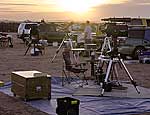
(Click images for larger versions.)
I ran into Tom W., Ron Boe, Greg Kettell, John Moschinger, Scott Kroepple, Brent Archinal and others whose names are escaping me at the moment. John ended up setting up next to me, and I enjoyed tossing words of encouragement back and forth over the course of the night. I brought my 6″ f/8 EQ newtonian and got set up on a piece of dirt with as few ant hills and ground squirrel holes as possible. Those things are real break-a-leg hazards after dark. Some of them were pretty roomy–you could probably stuff a full grown cocker spaniel in there if you tried. You might need some Crisco and a shoe horn though–
Anyway.
Don Machholz attended, and I caught him chatting with Brent next to his 6″ f/8 Criterion telescope.
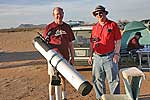
My scope (foreground), John Moschinger’s scope (background), and the rising Belt of Venus can be seen here:
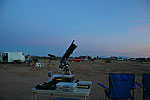
The rules for the AAMM event are pleasantly open to Go-to, Push-to and star hopping alike, with the point being that you have to observe each object visually. I went the star hopping route, because not only am I not equipped with Go-to or Push-to, but I get a lot of satisfaction from locating objects manually with charts, hands, and eyeballs. The sky conditions this night put every star hopping skill I’ve practiced over the past couple years to a whopping test. So, as much as I figured the Messier Marathon would be pretty challenging to begin with, locating objects through a widespread, morphing gauze of cirrus and alto-cumulus was a massive challenge.
Here you can see the view to the west at sundown.
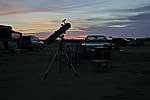
See those thick cirrus swatches? M74, M31, M32, M110 and others were hiding behind them at twilight. It was a little sad to know right off the bat that there was no way I was going to get all 110. Some of those objects were far enough north that they would rise again before morning twilight for a second chance. But M74 was just hosed. With advancing clouds, my plan to systematically find objects as twilight darkened went down the drain. I grabbed what I could, just above the cloud bank and started moving eastward while keeping an eye on any potential openings in the clouds that would draw me back west. I _almost_ caught M33, but the star hop from alpha-triangulum ended 2 degrees below an unyielding curtain of cloud.
I ran into a surprising frustration with M40. Ahh, M40. I’ve heard people complain about its loser status before, but it’s one of the 26 Messier Objects I haven’t had a chance to observe or sketch yet. I figured, hey, it’s just a double star. I should be able to find that easily. Heh. No. I should have researched it more before heading out, because, I wasn’t sure what was what. My otherwise awesome Tirion and Skiff Bright Star Atlas doesn’t even deign to mark it. Not even a disgruntled footnote =) So I got no help there. I just knew the general area–a couple of degrees northeast of Sigma U.Majoris. Well folks, there are a few double star candidates in the area. After about a half hour struggling over it, John slewed over and gave me a look through his scope. I noted one of the double stars in the eyepiece, but I just wasn’t 100% certain about it. So I messed around with it in my scope for another 20 minutes or so before Don Machholz walked up while making the rounds. He confirmed that I had my scope aimed at the right field, and then described which set of stars was M40. I re-centered the view, he took another look and confirmed that, yes, I had centered on the right object. Whew! That made my night. I hadn’t planned on sketching M40 that night. But I did after that just to preserve the moment of finding that beast after wasting so much time on it at a Messier Marathon of all things.
As the hunt eased into the overhead sky, cloud conditions got much better. I had been worried about the Virgo Galaxy Cluster, but it was actually the smoothest part of the whole marathon. I used an excellent finder chart by John Small that made the process a lot easier. There were lots of other fainter NGC galaxies prettying up the view, but the chart really narrowed down what’s what, and where. Folks typically settle in for a couple hours of shuteye after the Virgo Cluster, and now I know why. I was beat! I’ve been managing 2 or 3 all-night observing sessions a year, and haven’t had a horrible time with those. But the Messier Marathon turns out to be different. All the racing from object to object, twisting, hunching, nail-biting about which hole in the clouds to go for next, really takes the life out of you. Believe me, I was ready for a nap. But I also wanted to get a jump on the morning objects. Especially since I wasn’t sure what the clouds would be doing in another couple hours. And what if another one of my as-yet-unobserved objects turned out like M40? So I took a half-hour munchie break, and then started hitting the bits of Cygnus, Ophiuchus, and Scorpius that had risen. By 2:30 AM, I had found 79 objects, and Sagittarius was high enough to start whittling away at.
But then came a new cloud onslaught. It was horrible. It just wasn’t possible to slew 2 or 3 degrees from a main star to find an object anymore. I had to wait for one lucky, bright star to peek through a cloud, sight on it right away, and then slew in North-South/East-West treks of up to 8 to 12 degrees, counting field widths along the way: 1.4°…2.8°…4.2°…5.6°…7°…8.6°…and so on. And on parts of those journeys, I didn’t have even hints of stars to mark the progress of the view–only mottled puffs of cloud mass.
M55 was the most painful, but biggest success that morning. It was sunk deep into some sort of standing wave cloud that wouldn’t go away, but that thinned enough at odd moments to give some hope. I latched onto zeta-Saggitari and slewed 1° south and then 7.5° east across a mottled field of cloud. Then I turned the tracking motor on and waited. I was lamenting my plight to John, so he Go-to’d his way over to M55 and waited with me. As I was perusing my charts and looking for other cloud holes that might be promising, I heard John call out that he was starting to see stars in the eyepiece. I ran over to my eyepiece and gazed with anticipation. I had been very careful to slew what I thought was 7.5° east across the clouds. But what if I had only gone 6° or maybe 8.5°? Gradually the field cleared, and there, resting in the middle, was the wide, soft, circular glow of M55! It lasted a mere 5 seconds before fogging back up, but I had it! We exchanged congratulations, and moved on to the last objects we could before the sky got bright.
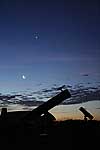
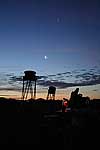
In all, I found 100 out 110 objects over the course of a very busy night. The ones I missed were M74, M33, M31, M32, M110, M76, M75, M72, M73, and M30. The highest count that night was 108. Don Machholz nabbed 102 (from memory, I believe!). Be sure to check out a report on the event by Andrew Cooper at Silicon Owl (click the 2006 Messier Marathon link under the Star Parties heading). Also see Sam Rua’s report, and the results compiled by SEDS. I can see where using Go To technology really would help on a night like this, but I’m pretty excited that I was able to duke it out with the clouds and star hop an even 100. Here’s to next year, and what a blast it would be to have clear skies.
End.
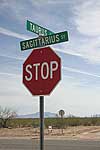
3 Replies to “2006 All Arizona Messier Marathon”
Comments are closed.
Excellent writeup, Jeremy. Congrats on starhopping to 100 Messier objects. That’s quite an accomplishment.
You have captured the essence and the fun of the Messier Marathon in your article. Thanks!
Jack Jones
SAC ALL-AZ MM Co-coordinator
Great writeup and photos. This was a tough one to start with! Maybe next year we will get a better shot at 110.